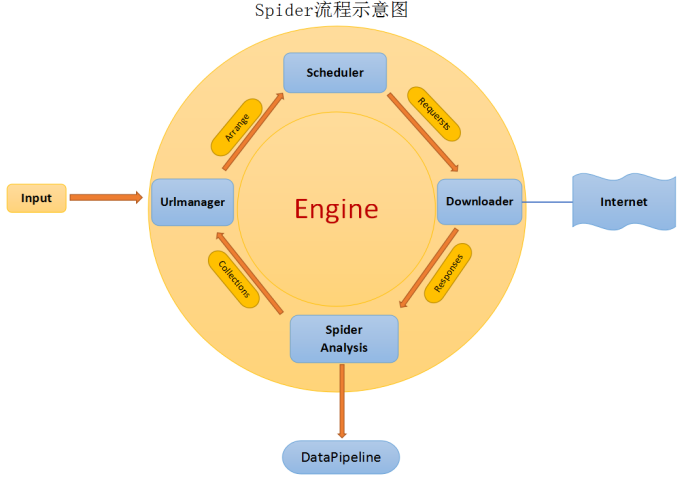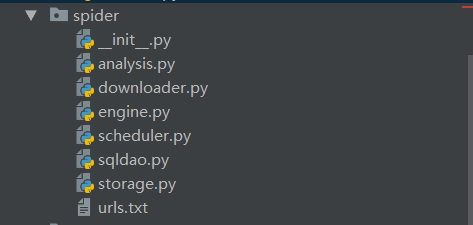爬虫spider流程示意图

根据以上流程简单实现爬虫功能,只是一种简单的做事风格,实际更复杂,不做具体讨论。
1. 目录

2. engine.py
# encoding=utf-8
import os
from spider.scheduler import Scheduler
def read_urls(file_path):
with open(file_path, 'r+', encoding='utf-8') as fp:
lines = fp.readlines()
return [line.strip() for line in lines if line.strip()]
def engine():
path = os.path.dirname(__file__) + '/urls.txt'
urls = read_urls(path)
htmls = Scheduler.download(urls)
data = Scheduler.analysis(htmls)
Scheduler.storage(data)
if __name__ == '__main__':
engine()
3. scheduler.py
# encoding=utf-8
from spider.downloader import Download
from spider.analysis import Analysis
from spider.storage import Storage
class Scheduler:
def __init__(self):
pass
@staticmethod
def download(urls):
urls = urls if isinstance(urls, list) else [urls]
htmls = []
# 下载
for url in urls:
htmls.append((url, Download.get(url)))
return htmls
@staticmethod
def analysis(_tuple):
"""[(url, html), (url, html)]"""
# 解析
data = []
for url, html in _tuple:
data.append(Analysis.parse(url, html))
return data
@staticmethod
def storage(data):
# 存储
for params in data:
Storage.storage(params)
4. downloader.py
# encoding=utf-8
import requests
class Download:
"""
1. 高效爬取
2. 常见反反爬虫手段
3. 数据量的问题:并发, 分布式
"""
def __init__(self):
pass
@staticmethod
def get(url, headers={}):
html = requests.get(url, headers=headers)
return html.text
@staticmethod
def post(url, data={}, headers={}):
html = requests.post(url, data=data, headers=headers)
return html.text
@staticmethod
def get_headers(params):
"""..."""
return params
5. storage.py
# encoding=utf-8
import hashlib
import pymysql
class Storage:
table = 'spider'
def __init__(self):
pass
@staticmethod
def storage(params):
"""
insert or update params
:param params:
:return:
"""
sql_util = SqlUtil('127.0.0.1', 3306, 'root', '123456', 'mysql')
_id = Storage.url2md5(url=params['url'])
if sql_util.exists(Storage.table, _id):
sql_util.update(Storage.table, where={'id': _id}, dict_value=params)
else:
sql_util.insert(Storage.table, params)
@staticmethod
def url2md5(url):
if isinstance(url, str):
url = url.encode('utf-8')
m2 = hashlib.md5()
m2.update(url)
return m2.hexdigest()
class SqlUtil:
where_dict = {
'$in': 'IN', '$like': 'LIKE',
'$eq': '=', '$reg': 'REGEXP',
'$ge': '>=', '$le': '<=',
'$gt': '>', '$lt': '<'
}
CREATE_DATABASE = 'CREATE DATABASE IF NOT EXISTS {database}'
CREATE_TABLE = 'CREATE TABLE {table} ({keys}, UNIQUE INDEX({index}))'
CREATE_INDEX = 'CREATE INDEX {index} ON {table}'
INSERT_TABLE = 'INSERT INTO {table} ({keys}) VALUES ({values})'
DELETE_TABLE = 'DELETE FROM {table} WHERE {where}'
UPDATE_TABLE = 'UPDATE {table} SET {update} WHERE {where}'
# UPDATE_TABLE_ALL = 'UPDATE {table} SET {update}'
SELECT_TABLE = 'SELECT {keys} FROM {table} WHERE {where}'
SELECT_TABLE_ALL = 'SELECT * FROM {table} WHERE {where}'
# INSERT_TABLE_UPDATE = 'INSERT INTO {table} {keys} VALUES {values} ON DUPLICATE KEY UPDATE {update}'
MAX_RETRY_TIMES = 3
def __init__(self, ip, port, user, password, database, charset='utf-8'):
"""
@functions:__init__
@param: ip, 端口号, 用户名, 用户密码, 数据库编码
@return:none
@summary: 初始化类参数, 获取数据库对应的数据库名即对应参数
"""
self.ip = ip
self.port = port
self.user = user
self.password = password
self.database = database
self.charset = charset
self.connect = None
self.cursor = None
self.connected = False
self.connection()
def check(self):
try:
self.connect.ping()
return True
except:
print('Server not available!')
self.close()
return self.connection()
def connection(self):
"""
@functions:connect
@param: none
@return: 如果连接正常,返回True; 否则返回 False
@summary: 连接数据库
@error desover:
解决error --- client does not support authentication
mysql> alter user 'root'@'localhost' identified with mysql_native_password by '123456';
Query OK, 0 rows affected (0.10 sec)
mysql> flush privileges;
Query OK, 0 rows affected (0.01 sec)
"""
self.connect = pymysql.connect(host=self.ip, port=self.port,
user=self.user, passwd=self.password,
db=self.database)
self.cursor = self.connect.cursor()
self.connect.ping()
return True
def close(self):
try:
self.connect.close()
except:
pass
def mogrify(self, sql, data=None):
"""sql防注入用法"""
return self.cursor.mogrify(sql, data)
def command(self, sql, data=[], find=False, _dict=True, _log=True):
if _log:
Logger.debug(sql)
if self.check():
if _dict:
cur = self.connect.cursor(pymysql.cursors.DictCursor)
else:
cur = self.connect.cursor()
if data:
cur.executemany(sql, data)
else:
cur.execute(sql)
results = cur.fetchall()
cur.close()
self.connect.commit()
if find:
return results
return True
def insert(self, table, value_list):
if not value_list:
return 0
value_list = value_list if isinstance(value_list, list) else value_list
keys, place, values = self.convert_insert_data(value_list)
sql = self.mogrify(SqlUtil.INSERT_TABLE.format(table=table, keys=keys, values=place))
return self.command(sql, data=values)
def find(self, table, where={}, keys=[], multi=True):
w_keys, w_place, w_values = self.convert_where_data(where)
if keys:
sql = SqlUtil.SELECT_TABLE.format(table=table, keys=keys, where=w_place)
else:
sql = self.mogrify(SqlUtil.SELECT_TABLE_ALL.format(table=table, where=w_place), w_values)
sql = self.mogrify(sql) if not multi else self.mogrify(sql) + ' limit 1'
return self.command(sql, find=True)
def exists(self, table, _id):
return self.find(table=table, where={'id': _id}, multi=False)
def update(self, table, update, where):
u_keys, u_place, u_values = self.convert_where_data(update)
w_keys, w_place, w_values = self.convert_where_data(where)
sql = SqlUtil.UPDATE_TABLE.format(table=table, update=u_place, where=w_place)
sql = self.mogrify(sql, u_values + w_values)
return self.command(sql)
def delete(self, table, where):
w_keys, w_place, w_values = self.convert_where_data(where)
sql = SqlUtil.DELETE_TABLE.format(table=table, where=w_place)
sql = self.mogrify(sql, w_values)
return self.command(sql)
def is_exists_table(self, table, database=None):
database = database if database else self.database
sql = f'show tables from {database};'
table_list = self.command(sql, find=True)
table_list = [table[f'Tables_in_{database}'] for table in table_list]
return True if table in table_list else False
def callproc(self, procname, args):
"""
@functions: callproc
@params procname: 存储过程函数名
@params args: 存储过程参数
@return: True if excute sucessfully else False
@summary: 执行存储过程
"""
if self.check():
cur = self.connect.cursor()
cur.callproc(procname, args)
cur.close()
self.connect.commit()
@staticmethod
def convert_insert_data(value_list):
if not value_list:
return [], [], []
keys = tuple(value_list[0].keys())
place = tuple(['%s'] * len(keys))
values = []
for item in value_list:
value = list()
for k in keys:
value.append(item[k])
values.append(tuple(value))
return ', '.join(keys), ', '.join(place), values
@staticmethod
def convert_where_data(where, _and=' and '):
""""
where={'age': {'$gt': 20}, 'name':'Jim'}
name=%s and age>%s
"""
keys = []
where_keys = []
where_vals = []
for k, v in where.items():
_k = k
_v = v
_join = '='
if isinstance(_v, dict):
for kk, vv in _v.items():
_join = SqlUtil.where_dict.get(kk, '=')
_v = vv
where_keys.append(f'{_k}{_join}%s')
where_vals.append(_v)
keys.append(_k)
place = _and.join(where_keys)
values = tuple(where_vals)
return ', '.join(keys), place, values
6. urls.txt
https://www.cnblogs.com/sui776265233/p/9719463.html